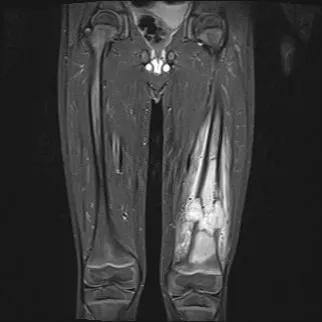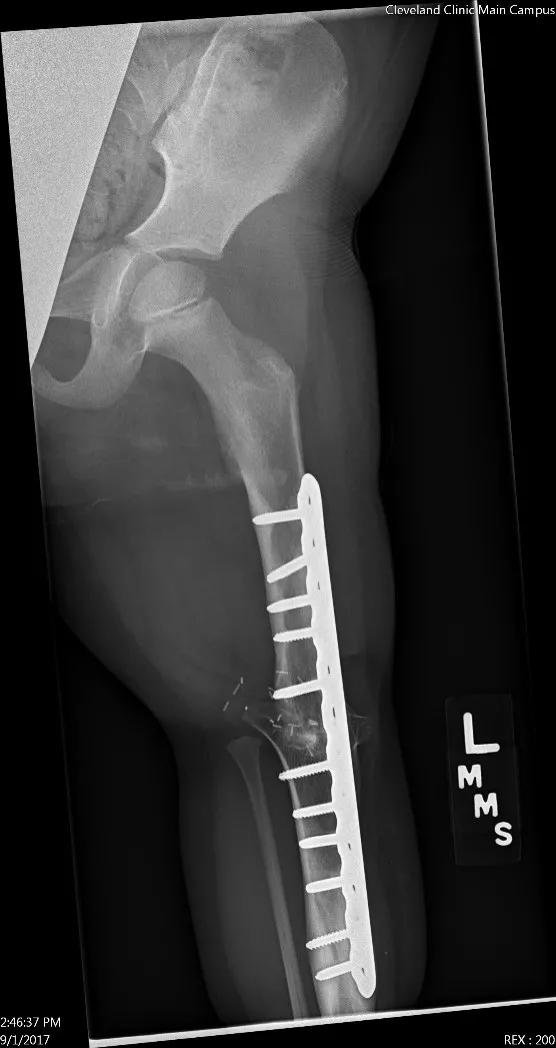A backwards foot serves as a knee joint

In September 2014, a 4-year-old boy with pain in his left knee was referred by his pediatrician to Cleveland Clinic’s Musculoskeletal Tumor Center/Pediatric Oncology where physicians diagnosed a high-grade osteosarcoma in the distal femur. Neoadjuvant chemotherapy was provided. The patient received 10 weeks of a multi-drug regimen that included Methotrexate and Adriamycin. Study of the en bloc resected specimen after initial chemotherapy showed necrosis of 90 percent of the tumor cells.
Advertisement
Cleveland Clinic is a non-profit academic medical center. Advertising on our site helps support our mission. We do not endorse non-Cleveland Clinic products or services. Policy

Osteosarcoma in the 4-year-old patient’s left knee.
After that initial chemotherapy, we faced a dilemma in terms of reconstruction because of the age and the immaturity of the patient’s bone. Treatment options for osteosarcoma include above-knee amputation and limb salvage with an internal expandable prosthesis that can be lengthened under a high power magnet. In this case, however, the child was not a candidate for an expandable implantable prosthetic device because they are made only for older children with larger bones.
A different limb-salvage surgery called rotationplasty seemed to be the best option. The procedure involves resecting the distal femur while retaining the femoral artery and sciatic nerve. The remaining limb is then rotated 180 degrees and reattached so the foot is pointing backwards and becomes the future knee joint.

Image showing the plate that was implanted to help the rotated tibia and femur grow together.
Rotationplasty is a rare procedure that was first described in the 1930s to treat femoral infection problems in patients with tuberculosis. Later in the 1940s and 1950s, it was further used to treat children born with the rare birth defect, proximal femoral focal deficiency. In the 1980s, European physicians adapted it for musculoskeletal tumors.
Rotationplasty in this situation is the best choice for patients, especially those who want to play sports because the procedure creates a functional-like knee joint out of the patient’s foot and ankle that is far superior to any above-knee amputation fitted with an external prosthesis. Patients who chose rotationplasty have a more serviceable limb than those who chose an above-knee amputation. This is especially true in younger children — ages 3- to 7-years-old —who still have a great deal of growing left to do.
Advertisement
Studies have shown that patients who opt for the procedure produce significantly higher functional scores on the Musculoskeletal Tumor Society assessment and health-related quality- of-life assessments than patients who opt for an above-knee amputation. They perform as a below-knee prosthetic wearer.
Rotationplasty is still rarely done, however, mainly because many osteosarcoma patients — the largest number of which are teenagers — do not like the appearance of the backwards foot at the end of the stump. In addition, because of their skeletal maturity, such patients are good candidates for reconstruction with metallic prostheses or allograft bone prosthetic replacement.
In this case, the rotationplasty was performed in November 2014. The surgery involved cutting out the distal femur to the knee joint, leaving wide margins around the tumor. The superficial femoral artery , the sciatic nerve and its branches were then coiled and the entire tibia was rotated 180 degrees. The distal femur was then inset in the proximal tibia using a metal plate to anchor and support the bone junction through the healing period.
Within about three weeks of the surgery, the patient began a new five-month round of chemotherapy. Such treatment is critical to kill any residual cancer cells shed by the osteosarcoma into the patient’s bloodstream before the tumor was removed. Without chemotherapy, a patient with osteosarcoma may have only about a 10 percent chance at survival. With post-surgical chemotherapy — as long as here is 90-95 percent necrosis of tumor cell in response to the neoadjuvant chemotherapy — the five year survivorship rate is over 90 percent
Advertisement
The patient finished chemotherapy in May 2015 and was cleared to be fitted for a prosthetic leg that would accommodate his new limb. By January 2017, he was running and jumping and still cancer-free.
Healing — it is difficult for the bones to heal after surgery because chemotherapy must be started within a few weeks of surgery and the drugs hinder bone regeneration. If a patient has complications (wound healing problems, too close of a margin, infection) during the short healing period before chemotherapy, surgeons may decide to go back and amputate so that chemotherapy is not delayed.
Complications — Adriamycin is a very toxic drug and can cause cardiomyopathy, potentially on rare occasions causing death or long-term heart problems. Methotrexate can be quite toxic. In addition, chemotherapy drugs may potentially make patients infertile so it’s appropriate to consider sperm or egg banking.
Tumor margins — It’s indicative on the surgeons part to get good tumor margins. Poor margins lead to local tumor recurrence with decreasing survival rates.
Symmetry — With younger patients, surgeons must calculate how much growth will occur in the proximal femur, so that when the child is done growing, their rotated ankle matches the level of the knee on the other side.
Advertisement
Advertisement

Should surgeons forgo posterior and lateral approaches?

How chiropractors can reduce unnecessary imaging, lower costs and ease the burden on primary care clinicians

Why shifting away from delayed repairs in high-risk athletes could prevent long-term instability and improve outcomes

Multidisciplinary care can make arthroplasty a safe option even for patients with low ejection fraction

Percutaneous stabilization can increase mobility without disrupting cancer treatment

Study shows that postop function is closer to normal than with total hip arthroplasty

A tailored approach combining injections, therapy and preventive care is improving outcomes for patients with elbow OA

Exploring new tools and techniques to improve the diagnosis and treatment of concussions.